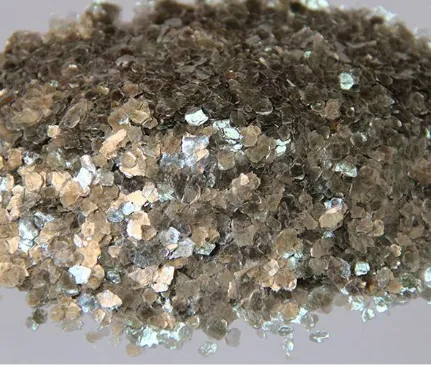Mica Flake: The brilliance of the microscopic world and the cornerstone of macroscopic applications
Mica, as a type of layered aluminosilicate mineral, plays multiple roles in human society due to its unique physical and chemical properties. One of its most prominent features is its ease of splitting into thin flakes. These mica flakes, seemingly insignificant, actually contain enormous value and are indispensable materials in modern technology and industrial production.

The layered structure of mica endows it with excellent cleavage properties, allowing it to be easily peeled off into extremely thin flakes
These flake of mica can reach a thickness of several micrometers or even thinner, yet still maintain their original electrical insulation, high temperature resistance, chemical stability, and excellent tensile strength. It is these outstanding performances that make mica flakes widely used in the electronics industry. For example, they are used as dielectric materials for capacitors, which can effectively store charges and ensure the normal operation of electronic devices; In semiconductor devices such as electronic tubes and transistors, mica flakes serve as insulating substrates to prevent current leakage and ensure device reliability.
In addition to the electronics industry, mica flake also shines in the fields of coatings, plastics, rubber, and more
Adding mica mineral flakes to coatings can enhance their weather resistance, wear resistance, and glossiness, and give them a unique luster effect, making the coating more decorative. In plastic and rubber products, mica flakes can improve the strength, rigidity, and thermal stability of materials, extending the service life of products. For example, mica flakes are often added to the paint of car bodies to make them more scratch resistant and present a metallic texture.
Mica flake is still widely used in the cosmetics industry
Because it is non-toxic, non irritating, and has good gloss and hiding power, mica flake is added to foundation make-up, eye shadow, lipstick and other cosmetics, which can give the product a delicate luster, cover defects, and improve the makeup effect.
Although mica flakes have a wide range of applications, we should also pay attention to the environmental impacts that may arise during their mining and processing. The implementation of sustainable mining and environmental protection measures is crucial for ensuring the rational utilization of mica resources. Meanwhile, with the continuous advancement of technology, people are actively exploring alternative materials for mica to reduce dependence on natural mica.
to make a long story short, mica flakes, This seemingly tiny substance, with its unique physical and chemical properties, supports many fields of modern technology and industry. From the operation of electronic devices to the beauty of daily life, the presence of mica flakes is everywhere. A deep understanding of the characteristics of mica flakes and their sustainable utilization will help us better realize their value and promote social progress and development.
Mica Flake FAQs
What is Mica Flake?
Mica Flake is a thin sheet-like material formed by processing natural or synthetic mica, mainly composed of potassium aluminum silicate. It has the characteristics of high glossiness, high temperature resistance, and strong insulation, and is widely used in fields such as coatings, plastics, cosmetics, and electronics industry.
What are the main uses of Mica Flake?
Coatings/paints: as functional fillers, enhance weather resistance, waterproofing, and glossiness.
Cosmetics: used for eye shadow, powder blusher and other products to provide pearlescent effect (in line with the cosmetics level standard).
Plastic/rubber: improves mechanical strength, heat resistance, and insulation performance.
Electronic industry: used as insulation materials (such as mica capacitors, insulation gaskets).
Building materials: added to fireproof boards or decorative materials.
What is the difference between Mica Flake and synthetic mica?
Natural mica flakes: directly extracted from ores, may contain trace mineral impurities, and have a variety of colors (such as gold, silver, and green).
Synthetic mica flakes: artificially prepared (such as fluorogold mica), with higher purity and lower heavy metal content, more suitable for cosmetics or high-end industrial applications.
What should be noted when using Mica Flake?
Safety: Cosmetics must pass heavy metal testing (such as lead and arsenic); Industrial grade requires prevention of dust inhalation.
Dispersion: It should be evenly dispersed in coatings or plastics to avoid clumping.
Temperature resistance: Natural mica can withstand temperatures of about 500-600 ° C, while synthetic mica can reach temperatures above 1000 ° C.
How to choose the specifications for Mica Flake?
Consider the following parameters based on application requirements:
Particle size: such as 520 μ m (cosmetics), 50100 μ m (industrial coatings).
Diameter to thickness ratio: A high diameter to thickness ratio (such as 50:1) enhances coverage and reflective effect.
Surface treatment: whether it has been modified with silane coupling agent (to enhance the adhesion with the substrate).
-
The Versatile World of Phlogopite Mica: Properties, Forms, and ApplicationsHabariJul.14,2025
-
The Versatile Applications of Calcined Mica: From Decoration to Industrial UseHabariJul.14,2025
-
The Role of Muscovite Mica in Industrial Insulation MaterialsHabariJul.14,2025
-
The Benefits of Using Expanded Clay Pebbles in Hydroponics and Soil GardeningHabariJul.14,2025
-
Innovative Applications of Mica Flake in Paints and CoatingsHabariJul.14,2025
-
Gardening Expanded Clay Usage: A Complete GuideHabariJul.14,2025
-
The Use of Natural Mica Powder in Skincare ProductsHabariJun.11,2025








